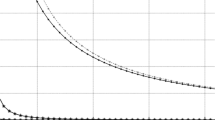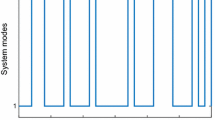Appendix
Proof of Lemma 1. The first factor in (3.10) is the weight ϱkj, and the integral sum contains L = 1 points. From the properties of the transition rate matrix it follows that \({\mathfrak{W}}=\mathop{\sum }\nolimits_{j=1}^{N}{\varrho }^{kj}=1\). Further presentation will use the notations γkj(y) ≜ ψkj(y) − ξkj(y) and \(\gamma (y)\triangleq \parallel {\gamma }^{kj}(y){\parallel }_{k,j = \overline{1,N}}\). Due to gk ≡ g, the difference γkj(y) can be written as
$$\begin{array}{l}{\gamma ^{kj}}(y) = {\delta _{kj}}\left( {1 + {\lambda _{jj}}h - {e^{{\lambda _{jj}}h}}} \right){\mathcal N}(y,h{f^j},hg) + (1 - {\delta _{kj}}){\lambda _{kj}}h\left( {1 - {e^{{\lambda _{jj}}h}}} \right){\mathcal N}(y,h{f^j},hg) + (1 - {\delta _{kj}}){\lambda _{kj}}{e^{{\lambda _{jj}}h}}\underbrace {\left( {h{\mathcal N}(y,h{f^j},hg) - \mathop \smallint \limits_0^h {e^{({\lambda _{kk}} - {\lambda _{jj}})u}}{\mathcal N}(y,u{f^k} + (h - u){f^j},hg)du} \right)}_{ \buildrel \Delta \over = {I}^{kj}(y)}.\end{array}$$
Using the Taylor formula up to the first- and second-order terms, estimate from above the integral in the right-hand side of (2.11):
$$\begin{array}{cc}\mathop{\int}\limits_{{{\mathbb{R}}}^{M}}| {\gamma }^{kj}(y)| dy\leqslant {\delta }_{kj}\left(1+{\lambda }_{jj}h-{e}^{{\lambda }_{jj}h}\right)+(1-{\delta }_{kj}){\lambda }_{kj}h\left(1-{e}^{{\lambda }_{jj}h}\right)\\ +(1-{\delta }_{kj}){\lambda }_{kj}{e}^{{\lambda }_{jj}h}\mathop{\int}\limits_{{{\mathbb{R}}}^{M}}| {J}^{kj}(y)| dy\leqslant {K}_{1}{h}^{2}+(1-{\delta }_{kj}){\lambda }_{kj}{e}^{{\lambda }_{jj}h}\mathop{\int}\limits_{{{\mathbb{R}}}^{M}}| {J}^{kj}(y)| dy,\end{array}$$
(A.1)
which holds for some constant K1 > 0. The difference \({J}^{kj}(y)\) is the numerical integration error in the case of the simple left rectangles scheme; according to [2],
$$\begin{array}{l}{J}^{kj}(y)=\frac{{h}^{2}}{2}\frac{d}{du}{\left.\left[{e}^{({\lambda }_{kk}-{\lambda }_{jj})u}{\mathcal{N}}\left(y,u{f}^{k}+(h-u){f}^{j},hg\right)\right]\right|}_{\,\,u = z}\\ =\frac{{h}^{2}}{2}{e}^{({\lambda }_{kk}-{\lambda }_{jj})z}{\mathcal{N}}\left(y,z{f}^{k}+(h-z){f}^{j},hg\right){\zeta }_{0}(y,z),\end{array}$$
where z = z(y) ∈ [0, h] is some parameter that depends on y, and
$${\zeta }_{0}(z)\triangleq {\lambda }_{kk}-{\lambda }_{jj}+{\langle {f}^{j},{f}^{k}-{f}^{j}\rangle }_{{g}^{-1}}-\frac{z}{h}\parallel {f}^{k}-{f}^{j}{\parallel }_{{g}^{-1}}^{2}+\frac{1}{h}{\langle y,{f}^{k}-{f}^{j}\rangle }_{{g}^{-1}}.$$
(A.2)
It is difficult to integrate the absolute value of \({I}^{kj}\) directly, since
$$\mathop{\int}\limits_{{{\mathbb{R}}}^{M}}| {J}^{kj}(y)| dy=\mathop{\int}\limits_{{{\mathbb{R}}}^{M}}| {J}^{kj}(y,{z}^{kj}(y))| dy$$
and the dependence zkj(y) is generally unknown. Therefore, find an upper bound for \(| {J}^{kj}| \). First of all, the inequality
$${\left\Vert y-{z}^{kj}{f}^{k}-\left(h-{z}^{kj}\right){f}^{j}\right\Vert }_{{(hg)}^{-1}}^{2}\geqslant \parallel y{\parallel }_{{(2hg)}^{-1}}^{2}-{\left\Vert {z}^{kj}{f}^{k}+\left(h-{z}^{kj}\right){f}^{j}\right\Vert }_{{(hg)}^{-1}}^{2}$$
(A.3)
can be verified in a straightforward way. Hence,
$$\begin{array}{cccc}\frac{{h}^{2}}{2}{e}^{({\lambda }_{kk}-{\lambda }_{jj})z}{\mathcal{N}}\left(y,{z}^{kj}{f}^{k}+\left(h-{z}^{kj}\right){f}^{j},hg\right)\\ =\frac{{h}^{2}}{2}{e}^{({\lambda }_{kk}-{\lambda }_{jj})z}{(2\pi )}^{-M/2}| hg{| }^{-1/2}{\rm{exp}}\left(-\frac{1}{2}{\left\Vert y-{z}^{kj}{f}^{k}-\left(h-{z}^{kj}\right){f}^{j}\right\Vert }_{{(hg)}^{-1}}^{2}\right)\\ \leqslant \frac{{h}^{2}}{2}{e}^{({\lambda }_{kk}-{\lambda }_{jj})z}{(2\pi )}^{-M/2}| hg{| }^{-1/2}{\rm{exp}}\left(-\frac{1}{2}\parallel y{\parallel }_{{(2hg)}^{-1}}^{2}\right)\\ \times {\rm{exp}}\left(\frac{1}{2}{\left\Vert {z}^{kj}{f}^{k}+\left(h-{z}^{kj}\right){f}^{j}\right\Vert }_{{(hg)}^{-1}}^{2}\right)\leqslant {h}^{2}{K}_{2}{\mathcal{N}}(y,0,2hg),\end{array}$$
(A.4)
where K2 > 0 is some constant. Then
$$\begin{array}{ccccc}\mathop{\int}\limits_{{{\mathbb{R}}}^{M}}| {J}^{kj}(y)| dy\leqslant {K}_{2}{h}^{2}\mathop{\int}\limits_{{{\mathbb{R}}}^{M}}{\mathcal{N}}(y,0,2hg)| {\zeta }_{0}(y,z)| dy\\ \leqslant {K}_{2}{h}^{2}\mathop{\int}\limits_{{{\mathbb{R}}}^{M}}\left|{\lambda }_{kk}-{\lambda }_{jj}+{\langle {f}^{j},{f}^{k}-{f}^{j}\rangle }_{{g}^{-1}}-\frac{z}{h}{\left\Vert {f}^{k}-{f}^{j}\right\Vert }_{{g}^{-1}}^{2}\right|{\mathcal{N}}(y,0,2hg)dy\\ +{K}_{2}{h}^{2}\mathop{\int}\limits_{{{\mathbb{R}}}^{M}}\left|\frac{1}{h}{\langle y,{f}^{k}-{f}^{j}\rangle }_{{g}^{-1}}\right|{\mathcal{N}}(y,0,2hg)dy\\ ={K}_{2}{h}^{2}\mathop{\int}\limits_{{{\mathbb{R}}}^{M}}\left|{\lambda }_{kk}-{\lambda }_{jj}+{\langle {f}^{j},{f}^{k}-{f}^{j}\rangle }_{{g}^{-1}}-\frac{z}{h}{\left\Vert {f}^{k}-{f}^{j}\right\Vert }_{{g}^{-1}}^{2}\right|{\mathcal{N}}(y,0,2hg)dy\\ +\sqrt{2}{K}_{2}{h}^{\frac{3}{2}}\mathop{\int}\limits_{{{\mathbb{R}}}^{M}}\left|\frac{1}{h}{\left\langle y,{g}^{-\frac{1}{2}}({f}^{k}-{f}^{j})\right\rangle }_{I}\right|{\mathcal{N}}(y,0,I)dy={K}_{3}{h}^{2}+{K}_{4}{h}^{\frac{3}{2}}\end{array}$$
(A.5)
for some nonnegative constants K3 and K4. Substituting these inequalities into the estimated integral of the absolute value of γkj gives
$$\mathop{\int}\limits_{{{\mathbb{R}}}^{M}}\left|{\gamma }^{kj}(y)\right|dy\leqslant {K}_{1}{h}^{2}+(1-{\delta }_{kj}){\lambda }_{kj}{e}^{{\lambda }_{jj}h}\left({K}_{3}{h}^{2}+{K}_{4}{h}^{\frac{3}{2}}\right)\leqslant {K}_{5}{h}^{\frac{3}{2}}$$
with some constant K5 > 0. In this case, condition (2.11) can be written as
$$\mathop{\rm{max}}\limits_{k = \overline{1,N}}\mathop{\sum }\limits_{j=1}^{N}\mathop{\int}\limits_{{{\mathbb{R}}}^{M}}| {\gamma }^{kj}(y)| dy\leqslant N{K}_{5}{h}^{\frac{3}{2}},$$
and inequality (2.13), which characterizes the difference between the conditional distribution \({\widehat{x}}_{T/h}\) and its first-order approximation realized by the time discretization of the differential observation system, takes the form
$$\mathop{\rm{sup}}\limits_{\pi \in \Pi }{\mathsf{E}}\{\parallel {\widetilde{X}}_{T/h}-{\widehat{X}}_{T/h}{\parallel }_{1}\}\leqslant 2T\left({\overline{\lambda }}^{2}h+N{K}_{5}{h}^{\frac{1}{2}}\right)\leqslant C{h}^{\frac{1}{2}}$$
(A.6)
for some constant C > 0.
The proof of Lemma 1 is complete.
Proof of Corollary 1. First of all, estimate the value \({\mathfrak{W}}\), letting λjj ≠ λkk for the sake of simplicity:
$$\begin{array}{ccccc}{\mathfrak{W}}={e}^{{\lambda }_{kk}h}+\mathop{\sum}\limits_{j:j\ne k}{\varrho }^{kj}\\ \leqslant 1+{\lambda }_{kk}h+\frac{{\lambda }_{kk}^{2}{h}^{2}}{2}+{K}_{6}{h}^{3}+\mathop{\sum}\limits_{j:j\ne k}{\lambda }_{kj}\frac{{\lambda }_{jj}h+\frac{{\lambda }_{jj}^{2}{h}^{2}}{2}-{\lambda }_{kk}h-\frac{{\lambda }_{kk}^{2}{h}^{2}}{2}+{K}_{7}{h}^{3}}{{\lambda }_{jj}-{\lambda }_{kk}}\\ \leqslant 1+\frac{{\lambda }_{kk}^{2}{h}^{2}}{2}+\mathop{\sum}\limits_{j:j\ne k}{\lambda }_{kj}{h}^{2}\frac{{\lambda }_{jj}^{2}-{\lambda }_{kk}^{2}}{2({\lambda }_{jj}-{\lambda }_{kk})}+{K}_{8}{h}^{3}\\ =1+\frac{{\lambda }_{kk}^{2}{h}^{2}}{2}+\mathop{\sum}\limits_{j:j\ne k}\frac{{h}^{2}{\lambda }_{kj}({\lambda }_{jj}+{\lambda }_{kk})}{2}+{K}_{8}{h}^{3}\\ =1+\mathop{\sum}\limits_{j:j\ne k}\frac{{h}^{2}{\lambda }_{kj}{\lambda }_{jj}}{2}+{K}_{8}{h}^{3}\leqslant 1,\end{array}$$
which holds for sufficiently small h and some positive constants K6, K7, and K8. In a similar fashion, it can be demonstrated that \({\mathfrak{W}}\leqslant 1\) for λkk = λjj as well. Next, determine the deviation of the scheme (3.13) from the reference (3.8), taking into account that gj ≡ g:
$$\begin{array}{cccccc}{\gamma }^{kj}(y)={\psi }^{kj}(y)-{\xi }^{kj}(y)\\ =(1-{\delta }_{kj})\left({\varrho }^{kj}{\mathcal{N}}(y,h{f}^{j},hg)-{\lambda }_{kj}{e}^{{\lambda }_{jj}h}\mathop{\int}\limits_{0}^{h}{e}^{({\lambda }_{kk}-{\lambda }_{jj})u}{\mathcal{N}}\left(y,u{f}^{k}+(h-u){f}^{j},hg\right)du\right)\\ =(1-{\delta }_{kj})\left({\varrho }^{kj}-{\lambda }_{kj}h{e}^{{\lambda }_{jj}h}\right){\mathcal{N}}(y,h{f}^{j},hg)\\ +\ (1-{\delta }_{kj}){\lambda }_{kj}{e}^{{\lambda }_{jj}h}\left(h{\mathcal{N}}(y,h{f}^{j},hg)-\mathop{\int}\limits_{0}^{h}{e}^{({\lambda }_{kk}-{\lambda }_{jj})u}{\mathcal{N}}\left(y,u{f}^{k}+(h-u){f}^{j},hg\right)du\right)\\ =(1-{\delta }_{kj})\left({\varrho }^{kj}-{\lambda }_{kj}h{e}^{{\lambda }_{jj}h}\right){\mathcal{N}}(y,h{f}^{j},hg)\\ +(1-{\delta }_{kj})\frac{{\lambda }_{kj}{h}^{2}}{2}{e}^{{\lambda }_{jj}h}\frac{d}{du}{\left.\left[{e}^{({\lambda }_{kk}-{\lambda }_{jj})u}{\mathcal{N}}\left(y,u{f}^{k}+(h-u){f}^{j},hg\right)\right]\right|}_{\,\,u = z},\end{array}$$
where z = z(y) ∈ [0, h] is some parameter that depends on y, and ζ0(z) is given by (A.2). Repeating completely the considerations (A.3)–(A.5), finally establish inequality (A.8) for the left rectangles scheme, which has a global accuracy of order \(\frac{1}{2}.\) The proof of Corollary 1 is completely.
Proof of Lemma 2. Using the Taylor formula up to the second-order terms and the properties of the transition rate matrix Λ, check condition (2.9) for (3.14):
$$\begin{array}{ccc}{\mathfrak{W}}=\mathop{\sum}\limits_{j,\ell }{\varrho }_{\ell }^{kj}=\mathop{\sum }\limits_{j=1}^{N}{\delta }_{kj}{e}^{{\lambda }_{kk}h}+(1-{\delta }_{kj}){\lambda }_{kj}h{e}^{\frac{({\lambda }_{kk}+{\lambda }_{jj})h}{2}}\\ =1+{\lambda }_{kk}h+\frac{{\lambda }_{kk}^{2}{h}^{2}}{2}+{C}_{kk}(h){h}^{3}+\mathop{\sum }\limits_{j:j\ne k}^{N}{\lambda }_{kj}h\left(1+{\lambda }_{kj}h+\frac{{\lambda }_{kj}^{2}{h}^{2}}{2}+{C}_{kj}(h){h}^{3}\right)\\ =1+\frac{{h}^{2}}{2}\mathop{\sum }\limits_{j:j\ne k}^{N}{\lambda }_{kj}{\lambda }_{jj}+C(h){h}^{3}.\end{array}$$
Here all functions \({\{{C}_{kj}\}}_{k,j}\) are bounded above by the constant \(\frac{{\rm{max}}_{k}| {\lambda }_{kk}{| }^{3}}{6}.\) Since \(\mathop{\sum }\nolimits_{j:j\ne k}^{N}{\lambda }_{kj}{\lambda }_{jj}\leqslant 0,\) condition (2.9) will hold for sufficiently small h: \({\mathfrak{W}}\leqslant 1.\) As a result,
$$\begin{array}{cc}{\gamma }^{kj}(y)=(1-{\delta }_{kj})\frac{{\lambda }_{kj}{h}^{3}}{24}{e}^{{\lambda }_{jj}h}\frac{{d}^{2}}{d{u}^{2}}{\left.\left[{e}^{({\lambda }_{kk}-{\lambda }_{jj})u}{\mathcal{N}}(y,u{f}^{k}+(h-u){f}^{j},hg)\right]\right|}_{\,\,u = z}\\ =(1-{\delta }_{kj})\frac{{\lambda }_{kj}{h}^{2}}{2}{e}^{{\lambda }_{jj}h}{e}^{({\lambda }_{kk}-{\lambda }_{jj})z}{\mathcal{N}}\left(y,z{f}^{k}+(h-z){f}^{j},hg\right)[{\zeta }_{0}^{2}(y,z)-{\zeta }_{1}],\end{array}$$
where again z = z(y) ∈ [0, h] is some parameter that depends on y and
$${\zeta }_{1}(z)\triangleq \frac{\partial }{\partial z}{\zeta }_{0}(z)=\frac{1}{h}\parallel {f}^{j}-{f}^{k}{\parallel }_{{g}^{-1}}^{2}.$$
(A.7)
The considerations similar to (A.3)–(A.5) finally lead to a variant of condition (2.11), \(\mathop{\rm{max}}\nolimits_{k = \overline{1,N}}\mathop{\sum }\nolimits_{j=1}^{N}\mathop{\int}\limits_{{{\mathbb{R}}}^{M}}| {\gamma }^{kj}(y)| dy\leqslant N{K}_{9}{h}^{2}\), as well as to inequalities (2.13),
$$\mathop{\rm{sup}}\limits_{\pi \in \Pi }{\mathsf{E}}\{\parallel {\widetilde{x}}_{T/h}-{\widehat{x}}_{T/h}{\parallel }_{1}\}\leqslant 2T\left({\overline{\lambda }}^{2}h+N{K}_{10}h\right)\leqslant CTh$$
(A.8)
for the left rectangles scheme. In the latter inequalities, K9, K10, and C are some positive constants. The proof of Lemma 2 is complete.
Proof of Lemma 3. Condition (2.9) is established by analogy with the proofs of Lemmas 1 and 2. According to [2], in view of gn ≡ g, the absolute values of the errors are bounded above:
$$| {\epsilon }_{1}(y)| \leqslant {h}^{5}{K}_{11}\mathop{\max }\limits_{u\in [0,h]}\left|\frac{{\partial }^{4}}{\partial {u}^{4}}\left[{e}^{({\lambda }_{kk}-{\lambda }_{jj})u}{\mathcal{N}}\left(y,u{f}^{k}+(h-u){f}^{j},hg\right)\right]\right|,$$
(A.9)
$$| {\epsilon }_{2}(y)| \leqslant {h}^{5}{K}_{12}\mathop{\rm{max}}\limits_{\begin{array}{l}(u,v)\in {D},\\ k = \overline{0,3}\end{array}}\left|\frac{{\partial }^{3}}{\partial {u}^{k}\partial {v}^{3-k}}\left[{e}^{({\lambda }_{kk}-{\lambda }_{ii})u+({\lambda }_{ii}-{\lambda }_{jj})v}{\mathcal{N}}\left(y,u{f}^{k}+v{f}^{i}+(h-u-v){f}^{j},hg\right)\right]\right|,$$
(A.10)
where K11 and K12 are some positive constants.
The derivative in (A.9) has the form
$$\begin{array}{cc}\frac{{\partial }^{4}}{\partial {u}^{4}}\left[{e}^{({\lambda }_{kk}-{\lambda }_{jj})u}{\mathcal{N}}\left(y,u{f}^{k}+(h-u){f}^{j},hg\right)\right]\\ ={e}^{({\lambda }_{kk}-{\lambda }_{jj})u}{\mathcal{N}}\left(y,u{f}^{k}+(h-u){f}^{j},hg\right)\left({\zeta }_{0}^{4}(u)+6{\zeta }_{0}^{2}(u){\zeta }_{1}(u)+3{\zeta }_{1}^{2}(u)\right),\end{array}$$
(A.11)
where ζ0 and ζ1 are given by (A.2) and (A.7). Estimating from above the integral of the absolute value of e1(y) similar to (A.5), obtain the inequality \({\mathop{\int}\limits}_{{{\mathbb{R}}}^{M}}| {e}_{1}(y)| dy\leqslant {K}_{13}{h}^{3};\) an analogous upper bound for ∣e2(y)∣ has the form \({\mathop{\int}\limits}_{{{\mathbb{R}}}^{M}}| {e}_{2}(y)| dy\leqslant {K}_{14}{h}^{3}\) with some nonnegative constants K13 and K14. In this case, inequality (2.13) reduces to \(\mathop{\rm{sup}}\limits_{\pi \in \Pi }{\mathsf{E}}\parallel {\widetilde{x}}_{T/h}-{\widehat{x}}_{T/h}{\parallel }_{1}\leqslant CT{h}^{2}\), for some constant C > 0 and a sufficiently small step h. The proof of Lemma 3 is complete.
Proof of Lemma 4. First, study the accuracy characteristics of the simple midpoint scheme (α = 0), and then make conclusions regarding its composite modification. Due to fj ≡ 0,
$${\psi }^{kj}(y)={\delta }_{kj}{e}^{{\lambda }_{jj}h}{\mathcal{N}}(y,0,h{g}_{j})+(1-{\delta }_{kj}){\lambda }_{kj}h{Q}^{kj}\left(y,\frac{h}{2}\right).$$
In addition, the difference γkj(y) = ψkj(y) − ξkj(y) can be represented as
$${\gamma }^{kj}(y)=(1-{\delta }_{kj}){\lambda }_{kj}{e}^{{\lambda }_{jj}h}\left[{Q}^{kj}\left(y,\frac{h}{2}\right)-\mathop{\int}\limits_{0}^{h}{Q}^{kj}(y,u)du\right],$$
and, according to [2], it satisfies the equality
$$\begin{array}{cc}{\gamma }^{kj}(y)=(1-{\delta }_{kj})\frac{{\lambda }_{kj}{h}^{3}{e}^{{\lambda }_{jj}h}}{24}\frac{{\partial }^{2}}{\partial {u}^{2}}{\left.{Q}^{kj}(y,u)\right|}_{u = z}\\ =(1-{\delta }_{kj})\frac{{\lambda }_{kj}{h}^{3}{e}^{{\lambda }_{jj}h}}{24}{Q}^{kj}(y,z)\left[{\eta }_{0}^{2}(y,z)-{\eta }_{1}(y,z)\right],\end{array}$$
where z = z(y) ∈ [0, h] is some parameter that depends on y,
$$\begin{array}{cc}{\eta }_{0}(y,z)\triangleq {\lambda }_{kk}-{\lambda }_{jj}-\frac{\frac{d}{dz}| z{g}_{k}+(h-z){g}_{j}| }{2| z{g}_{k}+(h-z){g}_{j}| }\\ +\frac{1}{2}{y}^{\top }{[z{g}_{k}+(h-z){g}_{j}]}^{-1}({g}_{k}-{g}_{j}){[z{g}_{k}+(h-z){g}_{j}]}^{-1}y\end{array}$$
(A.12)
and
$$\begin{array}{cc}{\eta }_{1}(y,z)\triangleq \frac{| z{g}_{k}+(h-z){g}_{j}| \frac{{d}^{2}}{d{z}^{2}}| z{g}_{k}+(h-z){g}_{j}| -{(\frac{d}{dz}| z{g}_{k}+(h-z){g}_{j}| )}^{2}}{2| z{g}_{k}+(h-z){g}_{j}{| }^{2}}\\ +{y}^{\top }{[z{g}_{k}+(h-z){g}_{j}]}^{-1}({g}_{k}-{g}_{j}){[z{g}_{k}+(h-z){g}_{j}]}^{-1}({g}_{k}-{g}_{j}){[z{g}_{k}+(h-z){g}_{j}]}^{-1}y.\end{array}$$
(A.13)
As a preliminary, estimate ∣γkj∣ from the above. The properties of the system (2.2) guarantee the existence of symmetric matrices g and G such that 0 < g ⩽ gn ⩽ G for all \(n=\overline{1,N}.\) Therefore,
$${Q}^{kj}(y,u)\leqslant {K}_{15}{\mathcal{N}}(y,0,hg),$$
(A.14)
where
$${K}_{15}=\frac{| G| }{| g| }\mathop{\rm{max}}\limits_{\begin{array}{l}k,j = \overline{1,N}:k\ne j\\ u\in [0,h]\end{array}}{e}^{({\lambda }_{kk}-{\lambda }_{jj})u}.$$
From the well-known property of determinants (see [5]) it follows that
$$| z{g}_{k}+(h-z){g}_{j}| =| z({g}_{k}-{g}_{j})+h{g}_{j}| =\mathop{\sum }\limits_{n=0}^{N}{z}^{n}{h}^{N-n}{G}_{kjn},$$
(A.15)
where Gkjn is the sum of all determinants of the matrices obtained from u(gk − gj) by replacing the n columns by the corresponding columns hgj. As a result,
$$\frac{d}{dz}| z{g}_{k}+(h-z){g}_{j}| =\mathop{\sum }\limits_{n=1}^{N}n{z}^{n-1}{h}^{N-n}{G}_{kjn}.$$
(A.16)
This implies the inequality
$$\left|\frac{\frac{d}{dz}| z{g}_{k}+(h-z){g}_{j}| }{2| z{g}_{k}+(h-z){g}_{j}| }\right|={h}^{-1}\left|\frac{\mathop{\sum }\limits_{n=1}^{N}n{\left(\frac{u}{h}\right)}^{n-1}{G}_{kjn}}{\mathop{\sum }\limits_{m=0}^{N}{\left(\frac{u}{h}\right)}^{m}{G}_{kjm}}\right|\leqslant \frac{{K}_{16}}{h}$$
for \({K}_{16}={\rm{max}}_{\begin{array}{l}k,j = \overline{1,N}:\\ k\ne j\end{array}}\frac{\mathop{\sum }\nolimits_{n=1}^{N}n\left|{G}_{kjn}\right|}{2{\rm{min}}_{w\in [0,1]}\left|\mathop{\sum }\nolimits_{m=0}^{N}{G}_{kjm}{w}^{m}\right|}.\) Thus, the value ∣η0∣ has the upper bound
$$| {\eta }_{0}| \leqslant {K}_{17}+\frac{{K}_{16}}{h}+\frac{{K}_{18}}{{h}^{2}}\parallel y{\parallel }_{I}^{2},$$
(A.17)
where \({K}_{17}={\rm{max}}_{\begin{array}{l}k,j = \overline{1,N}:\\ k\ne j\end{array}}| {\lambda }_{kk}-{\lambda }_{jj}| \) and \({K}_{18}=\parallel {g}^{-1}G{g}^{-1}{\parallel }_{2}^{2}\) is the square of the spectral norm of the matrix. Also, note that \({\mathop{\int}\limits}_{{{\mathbb{R}}}^{M}}\parallel y{\parallel }_{I}^{2}{\mathcal{N}}(y,0,hg)dy=h{\rm{tr}}(g)\).
Due to (A.17), the square of ζ0 can be estimated from above as
$${\eta }_{0}^{2}(y,u)\leqslant {K}_{21}+\frac{{K}_{22}}{{h}^{2}}\left(1+\parallel y{\parallel }_{I}^{2}\right)+\frac{{K}_{23}}{{h}^{3}}\parallel y{\parallel }_{I}^{2}+\frac{{K}_{24}}{{h}^{4}}\parallel y{\parallel }_{I}^{4},$$
(A.18)
with some positive constants K21, K22, K23, and K24. Using (A.15) and (A.16), write an upper bound for the absolute value of the first term in ζ1(y, u):
$$\begin{array}{ccc}\left|\frac{\left|z{g}_{k}+(h-z){g}_{j}\right|\frac{{d}^{2}}{d{z}^{2}}\left|z{g}_{k}+(h-z){g}_{j}\right|-{\left(\frac{d}{dz}\left|z{g}_{k}+(h-z){g}_{j}\right|\right)}^{2}}{2| z{g}_{k}+(h-z){g}_{j}{| }^{2}}\right|\\ =\left|\frac{\mathop{\sum }\limits_{n=0}^{N}{z}^{s}{h}^{N-n}{G}_{kjn}\mathop{\sum }\limits_{m=2}^{N}m(m-1){z}^{m-2}{h}^{N-m}{G}_{kjm}-{\left(\mathop{\sum }\limits_{\ell = 1}^{N}\ell {z}^{\ell -1}{h}^{N-\ell }{G}_{kj\ell }\right)}^{2}}{2{\left(\mathop{\sum }\limits_{s = 0}^{N}{z}^{s}{h}^{N-s}{G}_{kjs}\right)}^{2}}\right|\\ =\frac{1}{{h}^{2}}\left|\frac{\mathop{\sum }\limits_{n=0}^{N}{\left(\frac{z}{h}\right)}^{s}{G}_{kjn}\mathop{\sum }\limits_{m=2}^{N}m(m-1){\left(\frac{z}{h}\right)}^{m-2}{G}_{kjm}-{\left(\mathop{\sum }\limits_{\ell = 1}^{N}\ell {\left(\frac{z}{h}\right)}^{\ell -1}{G}_{kj\ell }\right)}^{2}}{2{\left(\mathop{\sum }\limits_{s = 0}^{N}{\left(\frac{z}{h}\right)}^{s}{G}_{kjs}\right)}^{2}}\right|\leqslant \frac{{K}_{25}}{{h}^{2}},\end{array}$$
where \({K}_{25}={\rm{max}}_{\begin{array}{l}k,j = \overline{1,N}:\\ k\ne j\end{array}}\frac{\mathop{\sum }\nolimits_{n=0}^{N}| {G}_{kjn}| \mathop{\sum }\nolimits_{m=2}^{N}m(m-1)| {G}_{kjm}| +{(\mathop{\sum }\nolimits_{\ell = 1}^{N}\ell | {G}_{kj\ell }| )}^{2}}{2{\rm{min}}_{w\in [0,1]}{(\mathop{\sum }\nolimits_{s = 0}^{N}{w}^{s}{G}_{kjs})}^{2}}.\) Next, the absolute value of the second term in ζ1(y, u) can be estimated from above as
$${y}^{\top }{[z{g}_{k}+(h-z){g}_{j}]}^{-1}({g}_{k}-{g}_{j}){[z{g}_{k}+(h-z){g}_{j}]}^{-1}({g}_{k}-{g}_{j}){[z{g}_{k}+(h-z){g}_{j}]}^{-1}y\leqslant \frac{{K}_{26}}{{h}^{3}}\parallel y{\parallel }_{I}^{2},$$
where \({K}_{26}=4\parallel {g}^{-1}G{g}^{-1}G{g}^{-1}{\parallel }_{2}^{2}\).
All these inequalities, together with the relation between the second and fourth moments of the Gaussian distribution, lead to the following variant of inequality (2.11):
$$\mathop{\sum }\limits_{j=1}^{N}\mathop{\int}\limits_{{{\mathbb{R}}}^{M}}| {\gamma }^{kj}(y)| dy\leqslant {K}_{27}h+{K}_{28}{h}^{2}+{K}_{29}{h}^{3},$$
where K27, K28, and K29 are some positive constants. This means that \({\mathop{\int}\limits}_{{{\mathbb{R}}}^{M}}| {\gamma }^{kj}(y)| dy=O(h)\) and, according to (2.13), \({\rm{sup}}_{\pi \in \Pi }{\mathsf{E}}\{\parallel {\widetilde{x}}_{T/h}-{\widehat{x}}_{T/h}{\parallel }_{1}\}=O({h}^{0}).\)
For an approximate calculation of ξkj, apply the composite midpoint scheme, dividing the integration interval [0, h] with the step h1+α. In this case,
$${\gamma }^{kj}(y)=(1-{\delta }_{kj})\frac{{\lambda }_{kj}{h}^{3+2\alpha }{e}^{{\lambda }_{jj}h}}{24}\frac{{\partial }^{2}}{\partial {u}^{2}}{\left.{Q}_{kj}(y,u)\right|}_{\,\,u = z}.$$
Repeating all the previous considerations of this proof for the composite midpoint scheme, finally establish its order of accuracy 1 + 2α:
$$\mathop{\sum }\limits_{j=1}^{N}\mathop{\int}\limits_{{{\mathbb{R}}}^{M}}| {\gamma }^{kj}(y)| dy\leqslant NC{h}^{1+2\alpha }.$$
Therefore, see (2.13), the global accuracy characteristic has the order p = min(1, 2α):
$$\mathop{\rm{sup}}\limits_{\pi \in \Pi }{\mathsf{E}}\{\parallel {\widetilde{X}}_{T/h}-{\widehat{X}}_{T/h}{\parallel }_{1}\}\leqslant CT{h}^{p}.$$
The proof of Lemma 4 is complete.
Proof of Corollary 2. According to (2.13), for preserving the second-order accuracy of the analytical approximation, it is necessary that the local numerical integration error at each step be of an order not exceeding O(h3). The composite midpoint scheme presented in Lemma 4 ensures this accuracy for calculating the single integral—the second term in (3.16)—when choosing α = 1.
Select a suitable scheme for calculating double integrals over a triangle included in the third term of (3.16). First of all, evaluate the approximation error of the integral in (2.16) by the simple midpoint scheme:
$$\begin{array}{cc}{\lambda }_{ki}{\lambda }_{ij}{e}^{{\lambda }_{jj}h}\mathop{\int}\limits_{0}^{h}\mathop{\int}\limits_{0}^{h-u}{R}^{kij}(y,u,v)dvdu=\frac{{h}^{2}}{2}{\lambda }_{ki}{\lambda }_{ij}{e}^{{\lambda }_{jj}h}{R}^{kij}\left(y,\frac{h}{3},\frac{h}{3}\right)\\ +{\lambda }_{ki}{\lambda }_{ij}{e}^{{\lambda }_{jj}h}\mathop{\int}\limits_{0}^{h}\mathop{\int}\limits_{0}^{h-u}{\chi }_{2}^{kij}(y,u,v)dvdu,\end{array}$$
where the function \({\chi }_{2}^{kij}(y,u,v)\) has the form
$${\chi }_{2}^{kij}(y,u,v)\triangleq \frac{1}{2}{\left(\left(z-\frac{h}{3}\right)\frac{\partial }{\partial z}+\left(w-\frac{h}{3}\right)\frac{\partial }{\partial w}\right)}^{2}{\left.{R}^{kij}(y,z,w)\right|}_{(z(y,u),w(y,v))}.$$
As was shown in [2], the inequality
$${\lambda }_{ki}{\lambda }_{ij}{e}^{{\lambda }_{jj}h}\mathop{\int}\limits_{0}^{h}\mathop{\int}\limits_{0}^{h-u}{\chi }_{2}^{kij}(y,u,v)dvdu\leqslant {h}^{4}{K}_{30}\mathop{\rm{max}}\limits_{\begin{array}{l}\ell = 0,1,2;\\ (z,w)\in {D}\end{array}}\left|\frac{{\partial }^{2}}{\partial {z}^{\ell }\partial {w}^{2-\ell }}{\chi }_{2}^{kij}(y,z,w)\right|$$
holds for some positive constant K30. Lemma 4 also estimates the second derivative, but of another function Qkj, which contains h2 in the denominator. A direct comparison of Qkj and Rkij allows concluding that the second derivative of Rkij will contain h2 in the denominator as well, i.e., \({\lambda }_{ki}{\lambda }_{ij}{e}^{{\lambda }_{jj}h}\mathop{\int}\nolimits_{0}^{h}\mathop{\int}\nolimits_{0}^{h-u}{\chi }_{2}^{kij}(y,u,v)dvdu\leqslant {h}^{2}{K}_{31}\) with some positive constant K31. Since the third order of accuracy is required, the latter equality indicates that the simple midpoint scheme does not ensure the necessary accuracy.
For calculating the double integral, use the composite midpoint scheme, dividing the domain of integration, a right-angled triangle with legs of length h, into similar triangles with legs h2. In this case,
$${\lambda }_{ki}{\lambda }_{ij}{e}^{{\lambda }_{jj}h}\mathop{\int}\limits_{0}^{h}\mathop{\int}\limits_{0}^{h-u}{\chi }_{2}^{kij}(y,u,v)dvdu\leqslant {h}^{4}{K}_{32}$$
with some positive constant K32, and hence (see (2.13)) the inequality
$$\mathop{\rm{sup}}\limits_{\pi \in \Pi }{\mathsf{E}}\{\parallel {\widetilde{X}}_{T/h}-{\widehat{X}}_{T/h}{\parallel }_{1}\}\leqslant CT{h}^{2}$$
holds. In other words, for realizing numerically the approximation of order s = 2, it suffices to use the composite midpoint schemes for calculating the single and double integrals with the discretization step h2.
The proof of Corollary 2 is complete.
Funding
This work was supported in part by the Russian Foundation for Basic Research, project no. 19-07-00187 A.










